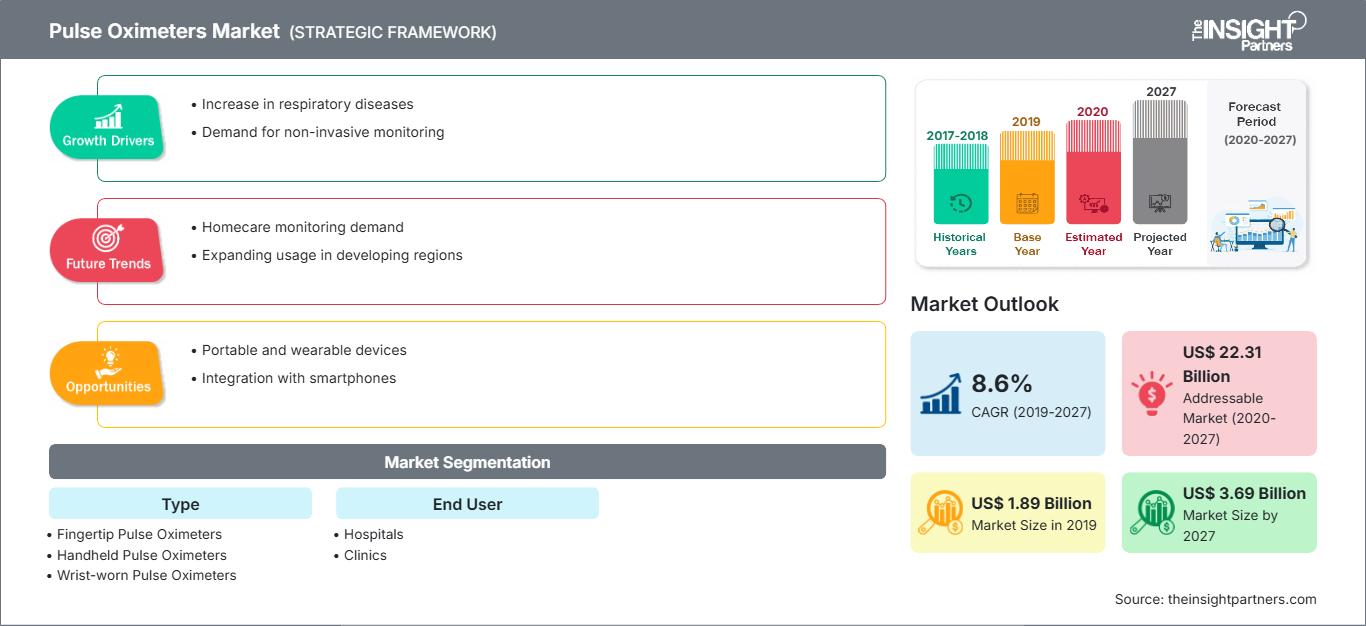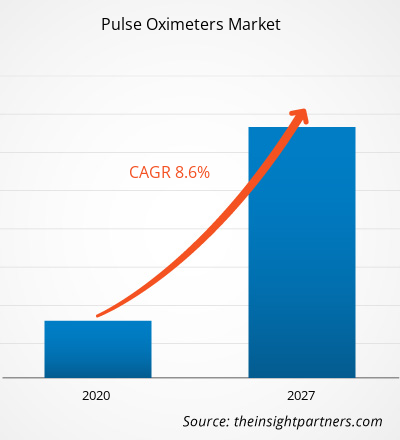Il mercato dei pulsossimetri è stato valutato a 1.892,00 milioni di dollari nel 2019 e si prevede che raggiungerà i 3.693,92 milioni di dollari entro il 2027; si prevede una crescita a un CAGR dell'8,6% tra il 2020 e il 2027.
Il pulsossimetro è un dispositivo non invasivo utilizzato per monitorare il livello di saturazione di ossigeno nel sangue. Si tratta di un piccolo dispositivo a clip che si attacca al dito o al lobo dell'orecchio. Viene utilizzato principalmente in terapia intensiva, in sala operatoria, in pronto soccorso e su pazienti ad alta quota per valutare l'ossigenazione del paziente e determinare se sia necessario un supplemento di ossigeno. Inoltre, il mercato dei pulsossimetri è utile per i pazienti con problemi cardiaci, problemi respiratori e broncopneumopatie croniche ostruttive.
Approfondimenti di mercato: la crescente prevalenza delle malattie respiratorie stimola la crescita del mercato
La crescente prevalenza delle malattie respiratorie è correlata alla riduzione delle dimensioni del lume delle vie aeree superiori con l'aumentare dell'età. Un'ampia percentuale della popolazione globale soffre di vari tipi di malattie respiratorie. Fumo, fattori genetici e infezioni sono tra i fattori comuni che causano malattie respiratorie. La broncopneumopatia cronica ostruttiva (BPCO), l'apnea notturna, l'aritmia cardiaca, le condizioni ischemiche, il diabete, l'ipertensione e l'asma sono tra le condizioni mediche che gravano in modo significativo sul sistema sanitario pubblico in diversi paesi. Secondo l'American Lung Association, la BPCO è la terza causa di morte negli Stati Uniti, dove oltre 16,4 milioni di persone ricevono una diagnosi di questa condizione. Inoltre, secondo il Dipartimento della Salute e dei Servizi Umani degli Stati Uniti, nel 2019 circa 25 milioni di persone negli Stati Uniti soffrivano di asma, una delle malattie respiratorie più diffuse al mondo. I pazienti affetti da questi disturbi respiratori presentano comunemente difficoltà respiratorie e carenza di ossigeno. Un pulsossimetro fornisce un metodo non invasivo e sicuro per la misurazione della saturazione di ossigeno.
Il crescente numero di casi di COVID-19 in tutto il mondo sta aumentando anche la domanda di pulsossimetri. Il monitoraggio continuo dei parametri respiratori è una delle fasi principali del trattamento dei pazienti affetti da COVID-19. Pertanto, per la gestione e il trattamento accurati dei casi di COVID-19, gli operatori sanitari dipendono da pulsossimetri e altri dispositivi di monitoraggio multiparametrico. Inoltre, diversi tipi di pulsossimetri sono ampiamente utilizzati per il monitoraggio di routine a domicilio.
Personalizza questo rapporto in base alle tue esigenze
Potrai personalizzare gratuitamente qualsiasi rapporto, comprese parti di questo rapporto, o analisi a livello di paese, pacchetto dati Excel, oltre a usufruire di grandi offerte e sconti per start-up e università
Mercato dei pulsossimetri: Approfondimenti strategici

- Ottieni le principali tendenze chiave del mercato di questo rapporto.Questo campione GRATUITO includerà l'analisi dei dati, che vanno dalle tendenze di mercato alle stime e alle previsioni.
Approfondimenti sui prodotti
Potrai personalizzare gratuitamente qualsiasi rapporto, comprese parti di questo rapporto, o analisi a livello di paese, pacchetto dati Excel, oltre a usufruire di grandi offerte e sconti per start-up e università
Mercato dei pulsossimetri: Approfondimenti strategici

- Ottieni le principali tendenze chiave del mercato di questo rapporto.Questo campione GRATUITO includerà l'analisi dei dati, che vanno dalle tendenze di mercato alle stime e alle previsioni.
In termini di tipologia, il segmento dei pulsossimetri da dito ha detenuto la quota maggiore del mercato dei pulsossimetri nel 2019 e si prevede che manterrà la sua posizione dominante e registrerà un CAGR più elevato nel mercato durante il periodo di previsione.
Approfondimenti sul tipo di sensore
In base al tipo di sensore, il mercato globale dei pulsossimetri è segmentato in riutilizzabili e monouso. Il segmento riutilizzabile ha detenuto la quota maggiore del mercato nel 2019 e si prevede che registrerà il CAGR più elevato durante il periodo di previsione. La crescita può essere attribuita all'aumento dei pazienti COVID-19 in tutto il mondo.
Approfondimenti sull'utente finale
In base all'utente finale, il mercato globale dei pulsossimetri è segmentato in ospedali, cliniche e altri. Il segmento delle cliniche ha detenuto la quota di mercato maggiore nel 2019 e si prevede che altri segmenti registreranno il CAGR più elevato durante il periodo di previsione.
Un pulsossimetro è un dispositivo piccolo e leggero per monitorare la quantità di ossigeno trasportata nell'organismo. I pulsossimetri da dito sono non invasivi, facili da usare e di dimensioni compatte, il che li rende un'opzione preferita per neonati e bambini. Si applica al polpastrello e invia due lunghezze d'onda luminose per misurare la frequenza cardiaca e il livello di ossigeno. Una volta completata la valutazione, lo schermo visualizza la percentuale di ossigeno e la frequenza cardiaca attuale. Le persone con problemi cardiaci o respiratori dipendono dai pulsossimetri da dito che li aiutano a gestire queste condizioni. Ad esempio, i pazienti con asma possono utilizzare i pulsossimetri per valutare la gravità degli attacchi. Secondo il CDC, negli Stati Uniti circa 19,2 milioni di adulti soffrono di asma. Letture accurate della frequenza cardiaca e della SpO2 sono particolarmente importanti per i pazienti che presentano frequenti cali dei livelli di ossigeno.
Gli operatori che operano nel mercato dei pulsossimetri adottano strategie di collaborazione e partnership per soddisfare le esigenze degli utenti finali attraverso l'introduzione di offerte tecnologicamente avanzate, e queste strategie supportano in modo significativo la crescita del mercato.
Approfondimenti regionali sul mercato dei pulsossimetri
Le tendenze regionali e i fattori che influenzano il mercato dei pulsossimetri durante il periodo di previsione sono stati ampiamente spiegati dagli analisti di The Insight Partners. Questa sezione illustra anche i segmenti e la geografia del mercato dei pulsossimetri in Nord America, Europa, Asia-Pacifico, Medio Oriente e Africa, America Meridionale e Centrale.
Ambito del rapporto di mercato dei pulsossimetri
| Attributo del rapporto | Dettagli |
|---|---|
| Dimensioni del mercato in 2019 | US$ 1.89 Billion |
| Dimensioni del mercato per 2027 | US$ 3.69 Billion |
| CAGR globale (2019 - 2027) | 8.6% |
| Dati storici | 2017-2018 |
| Periodo di previsione | 2020-2027 |
| Segmenti coperti |
By Tipo
|
| Regioni e paesi coperti | Nord America
|
| Leader di mercato e profili aziendali chiave |
|
Densità degli operatori del mercato dei pulsossimetri: comprendere il suo impatto sulle dinamiche aziendali
Il mercato dei pulsossimetri è in rapida crescita, trainato dalla crescente domanda degli utenti finali, dovuta a fattori quali l'evoluzione delle preferenze dei consumatori, i progressi tecnologici e una maggiore consapevolezza dei vantaggi del prodotto. Con l'aumento della domanda, le aziende stanno ampliando la propria offerta, innovando per soddisfare le esigenze dei consumatori e sfruttando le tendenze emergenti, alimentando ulteriormente la crescita del mercato.

- Ottieni il Mercato dei pulsossimetri Panoramica dei principali attori chiave
- pulsossimetri da dito
- pulsossimetri portatili
- pulsossimetri da polso
- pulsossimetri pediatrici
per tipo di sensore
- riutilizzabile
- monouso
per fine Utente
- Ospedali
- Cliniche
- Altro
Per area geografica
Nord America
- Stati Uniti
- Canada
- Messico
Europa
- Francia
- Germania
- Italia
- Regno Unito
- Russia
Asia Pacifico
- Cina
- India
- Sud Corea
- Giappone
- Australia
Medio Oriente e Africa
- Sudafrica
- Arabia Saudita
- Emirati Arabi Uniti
America centrale e meridionale
- Brasile
- Argentina
Azienda Profili
- Nonin
- Koninklijke Philips NV
- VYAIRE MEDICAL, INC.
- Smiths Medical
- Hill Rom Holding Inc.
- Edwards Lifesciences Corporation
- Medtronic
- Masimo
- Beurer GmbH
- Maxtec
- Analisi storica (2 anni), anno base, previsione (7 anni) con CAGR
- Analisi PEST e SWOT
- Valore/volume delle dimensioni del mercato - Globale, Regionale, Nazionale
- Industria e panorama competitivo
- Set di dati Excel
Report recenti
Testimonianze
Motivo dell'acquisto
- Processo decisionale informato
- Comprensione delle dinamiche di mercato
- Analisi competitiva
- Analisi dei clienti
- Previsioni di mercato
- Mitigazione del rischio
- Pianificazione strategica
- Giustificazione degli investimenti
- Identificazione dei mercati emergenti
- Miglioramento delle strategie di marketing
- Aumento dell'efficienza operativa
- Allineamento alle tendenze normative




















 Ottieni un campione gratuito per - Mercato dei pulsossimetri
Ottieni un campione gratuito per - Mercato dei pulsossimetri